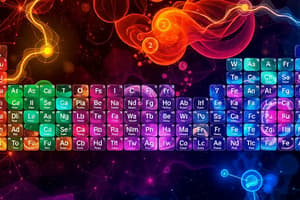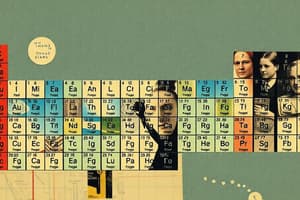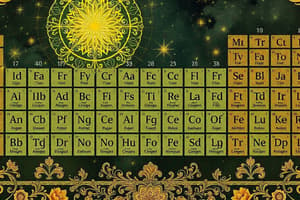Podcast
Questions and Answers
How did Henry Moseley's arrangement of elements by atomic number address a limitation of Mendeleev's original periodic table?
How did Henry Moseley's arrangement of elements by atomic number address a limitation of Mendeleev's original periodic table?
- It resolved discrepancies caused by inconsistencies in atomic weight, which sometimes led to elements being placed out of order based on their properties. (correct)
- It provided a theoretical basis for valence, which Mendeleev had determined empirically.
- It allowed for the inclusion of the noble gases, which Mendeleev had not accounted for in his original table.
- It eliminated the need to predict properties of undiscovered elements, as all elements were known by Moseley's time.
Why do elements within the same group of the periodic table exhibit similar chemical behaviors?
Why do elements within the same group of the periodic table exhibit similar chemical behaviors?
- They have similar ionization energies, making them equally likely to form ions.
- They have the same number of valence electrons, leading to similar bonding properties. (correct)
- They possess the same atomic mass, which determines their reactivity.
- They have a similar number of electron shells, which dictates how they interact with other atoms.
Which of the following statements accurately describes the trend of ionization energy across the periodic table?
Which of the following statements accurately describes the trend of ionization energy across the periodic table?
- Ionization energy trends are unpredictable and vary significantly from element to element.
- Ionization energy remains constant across a period due to the stability of electron configurations.
- Ionization energy generally decreases across a period because the effective nuclear charge increases, making it easier to remove an electron.
- Ionization energy generally increases across a period because the effective nuclear charge increases, making it harder to remove an electron. (correct)
How does the block designation (s, p, d, f) relate to the electron configuration of an element?
How does the block designation (s, p, d, f) relate to the electron configuration of an element?
In what way do metalloids challenge the simple classification of elements as either metals or nonmetals?
In what way do metalloids challenge the simple classification of elements as either metals or nonmetals?
How does the unique behavior of hydrogen differ from that of the alkali metals, despite its placement in Group 1?
How does the unique behavior of hydrogen differ from that of the alkali metals, despite its placement in Group 1?
Why are noble gases generally unreactive, and how does their electron configuration contribute to this property?
Why are noble gases generally unreactive, and how does their electron configuration contribute to this property?
How does the presence of transition metals in Periods 4 and 5 impact the chemical properties of these periods compared to Periods 2 and 3?
How does the presence of transition metals in Periods 4 and 5 impact the chemical properties of these periods compared to Periods 2 and 3?
In the context of the periodic table, how does electronegativity influence the nature of chemical bonds formed between elements?
In the context of the periodic table, how does electronegativity influence the nature of chemical bonds formed between elements?
Considering the trends in atomic size, why does atomic radius generally increase down a group in the periodic table?
Considering the trends in atomic size, why does atomic radius generally increase down a group in the periodic table?
How does the arrangement of lanthanides and actinides (f-block elements) below the main body of the periodic table affect our understanding of periodic trends?
How does the arrangement of lanthanides and actinides (f-block elements) below the main body of the periodic table affect our understanding of periodic trends?
How does the concept of 'metallic character' relate to trends in ionization energy and electronegativity across the periodic table?
How does the concept of 'metallic character' relate to trends in ionization energy and electronegativity across the periodic table?
How does the periodic table assist in predicting the stoichiometry of compounds formed between elements?
How does the periodic table assist in predicting the stoichiometry of compounds formed between elements?
Considering the applications of the periodic table, how does it aid in the design of new materials with specific properties?
Considering the applications of the periodic table, how does it aid in the design of new materials with specific properties?
How does the concept of 'effective nuclear charge' influence trends in ionization energy and atomic size?
How does the concept of 'effective nuclear charge' influence trends in ionization energy and atomic size?
How do electron shielding and effective nuclear charge interact to determine the atomic radius of an element?
How do electron shielding and effective nuclear charge interact to determine the atomic radius of an element?
What implications do the incomplete nature of Period 7 and the ongoing synthesis of new elements have for the future development of the periodic table?
What implications do the incomplete nature of Period 7 and the ongoing synthesis of new elements have for the future development of the periodic table?
How does the concept of variable valence in transition metals contribute to their ability to form a wide range of coordination complexes and catalysts?
How does the concept of variable valence in transition metals contribute to their ability to form a wide range of coordination complexes and catalysts?
Considering the role of carbon as the basis of organic chemistry, how does its unique bonding capability contribute to the diversity of organic compounds?
Considering the role of carbon as the basis of organic chemistry, how does its unique bonding capability contribute to the diversity of organic compounds?
How does the periodic table serve as a tool for predicting chemical reactivity and understanding the behavior of elements in extreme conditions, such as high temperatures or pressures?
How does the periodic table serve as a tool for predicting chemical reactivity and understanding the behavior of elements in extreme conditions, such as high temperatures or pressures?
Flashcards
Periodic Table
Periodic Table
A tabular display of chemical elements organized by atomic number, electron configuration, and recurring chemical properties.
Atomic Number
Atomic Number
The number of protons in the nucleus of an atom, determining the element's identity.
Periods (Periodic Table)
Periods (Periodic Table)
Horizontal rows in the periodic table, indicating the number of electron shells.
Groups (Periodic Table)
Groups (Periodic Table)
Signup and view all the flashcards
Dmitri Mendeleev
Dmitri Mendeleev
Signup and view all the flashcards
Henry Moseley
Henry Moseley
Signup and view all the flashcards
Electron Shells
Electron Shells
Signup and view all the flashcards
Valence Electrons
Valence Electrons
Signup and view all the flashcards
Alkali Metals
Alkali Metals
Signup and view all the flashcards
Alkaline Earth Metals
Alkaline Earth Metals
Signup and view all the flashcards
Transition Metals
Transition Metals
Signup and view all the flashcards
Halogens
Halogens
Signup and view all the flashcards
Noble Gases
Noble Gases
Signup and view all the flashcards
Metals
Metals
Signup and view all the flashcards
Nonmetals
Nonmetals
Signup and view all the flashcards
Metalloids
Metalloids
Signup and view all the flashcards
Ionization Energy
Ionization Energy
Signup and view all the flashcards
Electronegativity
Electronegativity
Signup and view all the flashcards
s-block
s-block
Signup and view all the flashcards
d-block
d-block
Signup and view all the flashcards
Study Notes
- The periodic table is a tabular display of the chemical elements, arranged by atomic number, electron configuration, and recurring chemical properties.
- Elements are presented in order of increasing atomic number, the number of protons in an atom's nucleus.
- The standard table is a grid with rows called periods and columns called groups.
- Elements in the same group share similar chemical properties.
History
- In 1869, Dmitri Mendeleev created a periodic table based on atomic weights, arranging elements by valence.
- Mendeleev predicted properties of missing elements; their later discovery validated his table.
- In 1913, Henry Moseley arranged elements by atomic number, resolving discrepancies in Mendeleev's table.
Structure
- The periodic table consists of periods (rows) and groups (columns).
- Elements in the same period have the same number of electron shells.
- Elements in the same group have the same number of valence electrons and similar chemical behavior.
Periods
- Period 1 contains only hydrogen and helium.
- Periods 2 and 3 contain eight elements each, lithium to neon, and sodium to argon, respectively.
- Periods 4 and 5 contain 18 elements each, including transition metals.
- Period 6 contains 32 elements, including the lanthanides.
- Period 7 is incomplete and contains the actinides and recently synthesized elements.
Groups
- Group 1, the alkali metals, are highly reactive metals.
- Group 2, the alkaline earth metals, are reactive, but less so than alkali metals.
- Groups 3-12 are transition metals, exhibiting variable valence and forming colored compounds.
- Group 16, the chalcogens, includes oxygen and sulfur.
- Group 17, the halogens, are highly reactive nonmetals.
- Group 18, the noble gases, are generally unreactive due to their full valence shells.
Element Categories
- Metals are typically lustrous, conductive, and malleable.
- Nonmetals generally lack metallic properties and are poor conductors.
- Metalloids (or semi-metals) have properties intermediate between metals and nonmetals.
Blocks
- The periodic table is divided into blocks based on the subshell being filled.
- Blocks are named after characteristic subshells: s-block, p-block, d-block, and f-block.
- The s-block contains Groups 1 and 2 (alkali and alkaline earth metals) plus helium.
- The p-block contains Groups 13 to 18.
- The d-block contains the transition metals (Groups 3 to 12).
- The f-block contains the lanthanides and actinides, typically placed below the main body.
Properties and Trends
- Atomic size generally increases down a group due to the addition of electron shells.
- Atomic size generally decreases across a period due to increasing nuclear charge.
- Ionization energy generally decreases down a group and increases across a period.
- Electronegativity generally decreases down a group and increases across a period.
- Metallic character increases down a group and decreases across a period.
Notable Elements
- Hydrogen is the most abundant element in the universe and has unique properties.
- Carbon is the basis of organic chemistry and is essential for life.
- Oxygen is vital for respiration and combustion.
- Iron is a key component of steel and is important in biology.
- Gold is a noble metal valued for its conductivity and resistance to corrosion.
- Uranium is a radioactive element used in nuclear power.
Applications
- The periodic table is used to predict chemical reactions and understand properties of elements and compounds.
- It is essential in chemistry, physics, materials science, and other scientific disciplines.
- It helps in synthesizing new materials and developing new technologies.
Studying That Suits You
Use AI to generate personalized quizzes and flashcards to suit your learning preferences.




